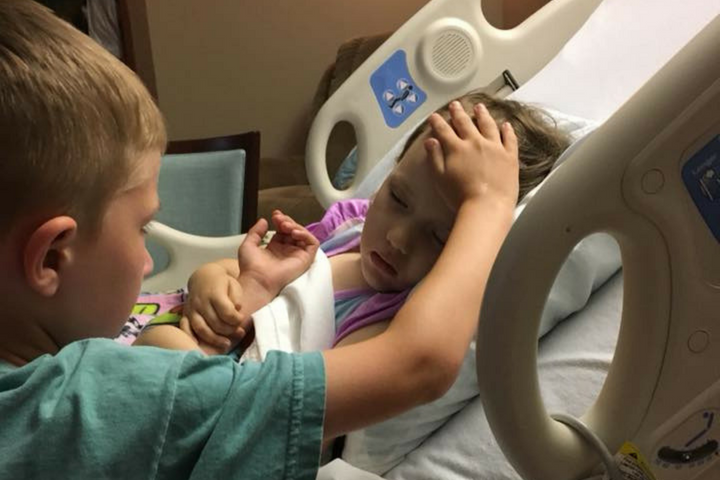“A little boy should not have to say goodbye to his partner in crime, his playmate, his best friend, his little sister.”

That was the message Matt Sooter of Arkansas posted on Facebook earlier this month, alongside a photo of his six-year-old son saying goodbye to his sister, Addy Joy.
READ MORE: Mother with terminal cancer gets dying wish to see daughter get married
The image, and the heartbreaking words, resonated around the world with people following the four-year-old’s battle with a rare tumour called Diffuse Intrinsic Pontine Glioma (DIPG).
“This isn’t how it’s supposed to be. But this is the broken world we live in,” Sooter wrote in a June 2 post on the group Hope for Addy Joy Fighting DIPG.
He explained that her symptoms had “progressed rapidly” and she was no longer eating, swallowing and was sleeping most of the time.
“Most likely she doesn’t have much time left,” he wrote.

Get weekly health news
READ MORE: Bride marries from hospital bed just hours before cancer takes her life
And she didn’t.
Hours later, the father posted on Facebook writing that Addy had died.
“This all happened so much faster than we expected, but that in itself is a blessing because she suffered so little at the end,” he wrote.
By the time Addy passed, the photo of her brother Jackson saying goodbye to her had gone viral. In an interview with The Washington Post, Sooter shared the moments before and after the photo was taken.
Sooter said that Jackson knew of his sister’s health condition, and that she may not survive. He refused to leave her side that night.
The two were playing and talking, but it was time to sleep for the night.
WATCH: Location impacts treatment for pediatric cancer patients

Jackson tucked his sister into bed, held her hand and whispered, “I love you.”
Minutes after that, Addy’s breathing and heartbeat became irregular. Several hours went by and the little girl died just after 1 a.m. local time.
Early morning, they woke up Jackson and told him she had died.
“He said, ‘Goodbye, Sissy,’ Sooter recalled to the Post.
And the family went home.
READ MORE: Olympic skier Bode Miller’s toddler drowns in neighbour’s pool
In another post days later, Sooter explained that Addy’s tumours, brain and spine would be donated for scientific research in hopes of finding a cure for DIPG.
“Our sweet girl loved helping people and giving gifts so we thought this would be an excellent way of showing her giving heart,” he wrote.
What is DIPG?
DIPG tumours are “highly aggressive” and difficult to treat because they’re located at the bottom of the brain, according to Boston Children’s Hospital.
They are found in the area of the brain that controls many of the body’s “most vital functions,” the hospital’s website explains.
READ MORE: Pediatric cancer research gets financial boost for Montreal-based project
They account for 10 per cent (about 300 individuals) of childhood central nervous system tumour diagnosis in the U.S., according to Boston Children’s Hospital.
The patients are most often between five and nine years old.











Comments